The future of skills, learning and work with GenAI
Introduction
On Friday, May 24, we had a very insightful session by Mr. Raghav Gupta head of Coursera in India and APAC. Technological advancements have largely impacted low-wage workers so far. But GenAI is quickly reshaping every job. This is creating a critical divide between those with access to AI skills and those without. To help mitigate the human cost of AI innovation, we need to bring about a reskilling revolution. In this session, Mr. Raghav Gupta provided insights into the transformative power of GenAI and how it influences productivity, innovation, and competitiveness in the business world. He also spoke about Coursera’s own initiatives in skilling people in generative AI.
About Mr Raghav Gupta
Mr Raghav Gupta leads Coursera in India and APAC. He is responsible for growing Coursera’s consumer and enterprise business in the region, thereby bringing the world’s best education to learners across Asia Pacific.
Mr. Gupta has 20 years of experience across consumer, internet and management consulting industries in India, Southeast Asia, and Europe. Previously, he was India Country Manager at BlaBlaCar, an inter-city carpooling service. As a management consultant for 15 years, Mr. Gupta led the Retail Practice of Strategy& (erstwhile Booz & Co.) in India and served as President of Technopak Advisors.
Mr. Gupta holds an MBA from INSEAD in France and a post-graduate degree in fashion business management from the National Institute of Fashion Technology in New Delhi.
The impact of automation
Many low skilled jobs are at the risk of disappearing due to automation. This was highlighted in a famous 2017 paper. Covid accelerated this trend. During Covid, remote work and digitalization became the norm.
In November 2022, Generative AI appeared on the horizon putting at risk even high skill jobs. It is estimated that up to 49% of workers could have 50% or more of their tasks exposed to LLMs. Higher jobs are associated with increased exposure to ChatGPT. In short, jobs at all education levels are exposed.
In India, by 2027, 22% of jobs are likely to change significantly. Even if entire jobs do not get automated, many tasks that make up these jobs will be.
At the G20 meet in July/August 2023, CFOs indicated that they want to unlock $4.4 tn. in productivity gains from AI. It is estimated that GenAI can unlock $ 621 billion of productivity gains in India alone.
In certain roles, there will be a massive impact. About 75% of the impact will be felt in: Sales/Marketing/Product and R&D/Software engineering (Corp IT)/ Software engineering (Product Development)/ Customer operations.
BCG and HBS did a study involving 758 consultants who were given some work related to data analytics. Without GPT, the performance varied over a wide range. After being trained on GPT, the average performance improved by 43% while the variation significantly narrowed.
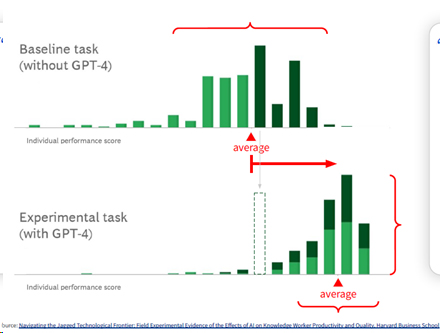
Whether AI will replace human beings is a subject of debate. But we can now state confidently that managers who use AI will replace managers who do not use AI. Similarly, in educational institutions, faculty who use AI will replace faculty that do not use AI.
According to Cognizant CEO, Mr S. Ravi Kumar, to reduce the skills inequality, “ We need a new generation of reskilling on a vast scale.”
Generative AI is not technical in nature. It is a general-purpose technology like Google Search or MS Excel. So, we should all take an interest in it and start using it.
We should also note that human skills are becoming even more important in a digital world. These include empathy, negotiation, problem solving, creativity, synthesis, organizational awareness, and ability to learn. We should be able to leverage technology and human skills to achieve the best outcomes.
Coursera
Coursera was set up in 2012 by Stanford professors, Andrew Ng and Daphne Koller to establish a lifelong learning ecosystem. It has enrolled 145 million + learners and 325+ educator partners. When Coursera was set up, it was essentially a B2C platform. Since 2016, it has become an institutional platform. Now, besides the consumer platform, there are Coursera for business, Coursera for campus and Coursera for government. The Coursera platform now caters to more than 7000 institutions.
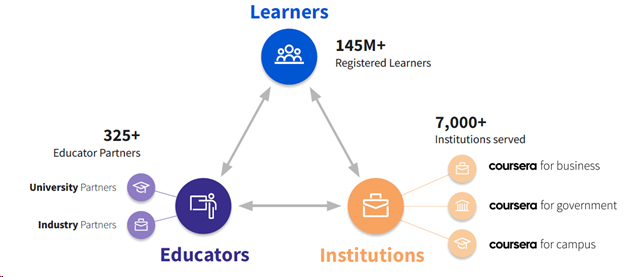
Coursera is partnering with many leading educational institutions. Seeing the need for industry aligned skilling, Coursera is also working closely with companies. Who better to learn about social media from than Meta, sales than from Salesforce and so on.
The leading countries for the usage of Coursera are: US -26 mn, India – 22.2 mn, Mexico-6.1 mn, Brazil- 5.4 mn and China- 3.8 mn.
Coursera in India
The large number of users in India indicates the growing appetite for high quality education and the aspiration to get ahead in life. The median age is 29. Men make up 61% and women 39%. Mobile accounts for 54%.
There was a massive adaptation of the platform in India during Covid. But even after Covid, the number of enrolments has continued to grow impressively. The only explanation is that the platform provides high quality value to learners.
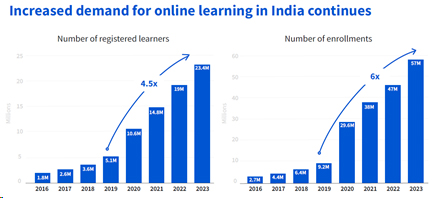
The leading courses in India, mostly around digital and business, include:
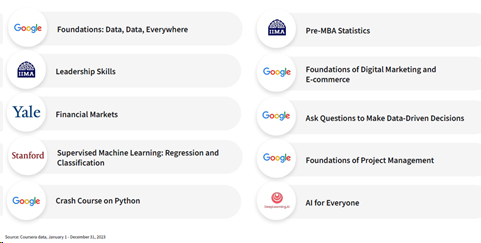
Offerings
Coursera offerings are bucketed into:
Gen AI academy: For upskilling, i.e. new skills in current job. The Coursera CEO himself has launched a couple of courses: Navigating Gen AI and Using Gen AI as your thought partner.
Career Academy: For reskilling, i.e. skills for a new job
Machine translation which uses AI to translate courses, personalized tutoring and career guidance, Course Builder to curate custom content and proctoring tools to ensure academic integrity during assessments are the various enablers.
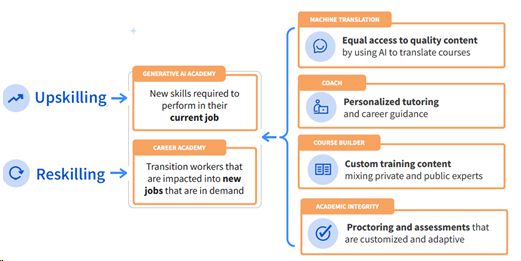
Concluding remarks
AI will not take away our jobs. If we play our cards right, AI will take our jobs to the next level.
Q&A
At Coursera, the importance of GenAI and its implications have been appreciated at the leadership level. The CEO himself is teaching courses on GenAI and leveraging Gen AI.
Mr. Gupta recalls that data and analytics had a big impact when it arrived a few years back. The impact of GenAI maybe 10-20 times more.
Coursera has realized the need for high quality content to educate people on GenAI. The GenAI Academy has a wide range of courses. The courses include GenAI for everyone, GenAI for leaders and GenAI for job roles. Educators can harness Course Builder to build their own course content.
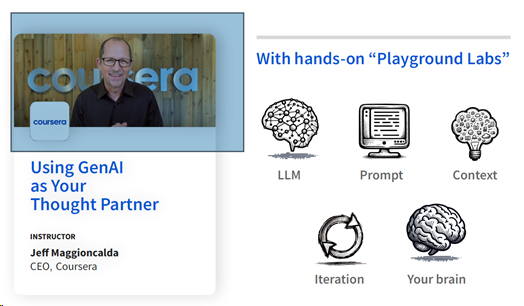
Mr. Gupta himself has invested a lot in learning about GenAI. He has attempted to incorporate GenAI into his work and improve productivity and quality.
GenAI is not only for teachers. MBAs must take interest in GenAI and get their hands dirty. There is a course by the Coursera CEO, Using GenAI as your thought partner. This is a good starting point to appreciate how GenAI can be leveraged.
Courses alone will not solve the problem. GenAI is not an overarching solution to the unemployment problem. Industry aligned skilling must be part of the solution. Campuses are finding it difficult to meet all the industry needs on their own. So, they must collaborate with other universities. One way is through in person visits of faculty from other universities. But online platforms could also be a way to go.
There should also be active collaboration between industry and academia. Students appreciate content coming from industry. This can help them to build industry relevant skills.
Companies are investing heavily too in upskilling. For example, Reliance has about 200,000 employees. To promote a culture of learning, Coursera access has been provided to all the employees and their family members. Such learning can help employees to stay at the cutting edge of employability.
We should not treat this as an either/or question. We should see it as an and question, i.e. how the two can be combined to deliver the best outcomes. Mr. Gupta’s own children are doing campus-based courses. About 80-90% of their instruction is offered on campus. But the remaining 10-20% is consumed through online learning. This kind of hybrid learning will be the way to go. Coursera on Campus has been designed to augment campus teaching.
But fully online degrees are also becoming popular. IIT Madras has an online course BSc (Data Science). Some 20,000 students are enrolled. https://study.iitm.ac.in/ds/
IIT Guwahati also offers a similar course: https://iitg.ac.in/acad/programmes/bsc.php
For students who make it to only Tier 3 engineering colleges, such online courses offered by world class instructors may make sense. About one third of the students in the US are pursuing a Masters courses in purely online mode. They have already gone through their undergrad courses and established their network. Now they might not want to disrupt their job or family life.
In short, we must try to combine the two forms of learning. There are enough circumstances where online is a powerful mechanism. However, in general, online learning need not be viewed as a substitute for face-to-face teaching.
As Dr Prasad mentioned, the low completion rates in online courses are possibly because of low levels of engagement. Swayam is a good example. Mr. Gupta joked that even in the classroom, only the students on the first bench may be fully engaged!
Mr. Gupta explained that for a course to succeed, there should be a purpose and motivation. Where students enroll on Coursera as part of their credit and must take an exam to earn the credit, the completion rate is as high as 95%. But in the case of those who go to the consumer platform to view videos or take audit courses, the completion rates may be very low, say 5%.
For course completion, the prerequisites are motivation and skin in the game. High quality content is essential. Great teachers in classroom mode must be enabled to teach equally well in an online environment. The credentials of the education provider also matter.
Note: We had the privilege of listening to Prof Andrew Thangaraj of IIT Madras about two years back. Here is a summary of some relevant remarks he made in that webinar conducted by TIMES Higher Education.
It is a myth that face-to-face education guarantees superior student engagement. In graduate programs, the people who get admitted are clear and motivated about what they want. Unfortunately, in undergraduate education in India, that's not true. People come into college because their dad and mom pushed them into that program. Some come because their parents think they can get better dowry that way! Even in his own class, Prof Thangaraj has seen that some students have no interest in electrical engineering. Many of them end up in management. As teachers, we think we are doing a great job. But are we tracking everything that is going on? Prof Thangaraj estimates that about 20% of his class keeps checking WhatsApp messages!
When Coursera began, it mostly offered longer courses. But today, considering the learner profiles and requirements, there are also 200,000 + video clips. Students can take a quick look. Suppose we have a doubt on the use of Pivot tables. These clips can be of great help.
Today, there are some 6500+ courses available on Coursera. But there are also more than 3400 projects where we can learn a tool (such as Power BI) in less than 2 hours. There are also 700+ specializations. In short, Coursera has various learning formats available. These are arranged in stackable formats and enable flexible learning and credit accumulation.
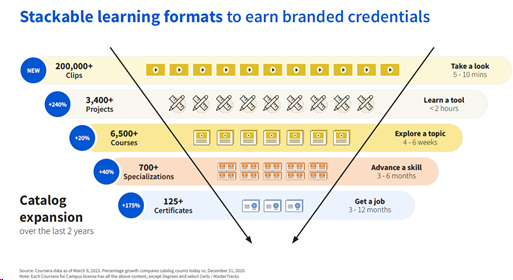
This cannot be attributed to LLMs. There is no decline in the number of jobs. Job growth will continue but the focus will be on productivity. The job situation is reflective of a wider global slowdown. The IT services industry, traditionally a massive employer, has gone slow in recruiting people. Elections in countries like USA and India also imply muted investments on the part of companies. This wait and watch attitude of companies probably explains the weak placement trends on the campuses.
Indians consider education to be every important. There is a thirst for high quality education: content and credentials. Indians are value conscious. High quality education must be provided at affordable prices.
Algorithmic biases are a major concern today. Mr. Gupta explained with an example how to deal with this problem. Coursera has developed Course Builder to create content. The LLMs only work on the content available on the platform and not on the wider platform to prevent hallucination. The platform has high quality content curated by experts. This significantly reduces the chances of hallucination, though there is always a slight possibility of the answer not being 100% correct. (That is why we must always critically examine the responses given by an LLM.)
One participant, a professor, wondered whether students really learn much in the online mode. She mentioned that once she asked students to do a course on Coursera. They came back within minutes claiming they had completed the course. Mr. Gupta responded that if students are just asked to audit a course on the consumer platform, they may take shortcuts, such as watching a video clip. Faculty members should use Coursera on Campus. This involves exams, assessments, and credits. So, the students will be forced to learn. The consumer platform is only for self-motivated students.
Due to LLMs, business models, staffing and the cost structure may change. This can have major implications. This should be factored into strategic planning exercises. LLMs will be applied in many fields. We should be able to visualize these applications. The Coursera CEO in his course has explained how to use LLMs to finetune strategy.
Dr Prasad emphasized that human involvement is critical even in online learning. Faculty have an important role to play. Personalization is critical. Every institution attracts a certain kind of students. The needs of this segment must be kept in mind. The cultural aspects are important. Faculty should be properly inducted and trained in how to leverage AI. The emphasis should be on outcomes. Content alone is not enough. The fact that Swayam is struggling is not surprising. Building an online course does not happen overnight. Faculty must work hard.
